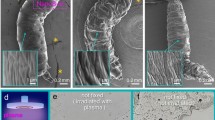Abstract
Dense inclusion bodies were observed under the STEM mode of a scanning electron microscope to occupy peripheral locations in air-dried filaments ofBeggiatoa alba B18LD, and they were determined by energy-dispersive x-ray microanalysis to consist almost entirely of sulfur. These inclusions conform in position and size (220–275 nm in diameter) to bodies seen in thin sections to be both membrane-bounded and enclosed within pockets penetrating the individual cell from the cytoplasmic membrane.
Similar content being viewed by others
Literature Cited
Baxter, M., Jensen, T. 1980. A study of the methods forin situ x-ray energy dispersive analysis of polyphosphate bodies inPlectonema boryanum. Archives of Microbiology126:213–215.
Hageage, G. J., Eanes, E. D., Gherna, R. L. 1970. X-ray diffraction studies of the sulfur globules accumulated byChromatium species. Journal of Bateriology101:464–469.
Kran, G., Schlote, F. W., Schlegel, H. G. 1963. Cytologische Untersuchungen anChromatium okenii Perty. Naturwissenschaften50:728–730.
Kuypers, G. A. J., Roomans, G. M. 1979. Mercury-induced loss of K+ from yeast cells investigated by electron probe x-ray microanalysis. Journal of General Microbiology115:13–18.
Lawry, N. H., Jensen, T. E. 1979. Deposition of condensed phosphate as an effect of varying sulfur deficiency in the cyanobacteriumSynechococcus sp. (Anacystis nidulans). Archives of Microbiology120:1–7.
Maier, S., Murray, R. G. E. 1965. The fine structure ofThioploca ingrica and a comparison withBeggiatoa. Canadian Journal of Microbiology11:645–655.
Nicolson, G. L., Schmidt, G. L. 1971. Structure of theChromatium sulfur particle and its protein membrane. Journal of Bacteriology105:1142–1148.
Schmidt, G. L., Kamen, M. D. 1970 Variable cellular composition ofChromatium in growing cultures. Archiv für Mikrobiologie73:1–8.
Schmidt, G. L., Nicolson, G. L., Kamen, M. D. 1971. Composition of the sulfur particle ofChromatium vinosum strain D. Journal of Bacteriology105:1137–1141.
Strohl, W. R., Geffers, I., Larkin, J. M. 1981. Structure of the sulfur inclusion envelopes from four beggiatoas. Current Microbiology6:75–79.
Strohl, W. R., Howarl, K. S., Larkin, J. M. 1981. Ultrastructure ofBeggiatoa alba strain B15LD. Journal of General Microbiology, in press.
Strohl, W. R., Larkin, J. M. 1978. Enumeration, isolation, and characterization ofBeggiatoa from freshwater sediments. Applied and Environmental Microbiology36:755–770.
Author information
Authors and Affiliations
Rights and permissions
About this article
Cite this article
Lawry, N.H., Jani, V. & Jensen, T.E. Identification of the sulfur inclusion body inBeggiatoa alba B18LD by energy-dispersive X-ray microanalysis. Current Microbiology 6, 71–74 (1981). https://doi.org/10.1007/BF01569006
Issue Date:
DOI: https://doi.org/10.1007/BF01569006




